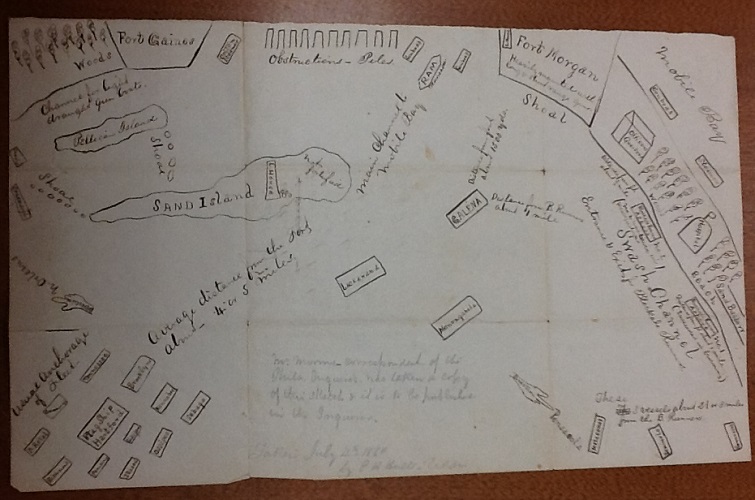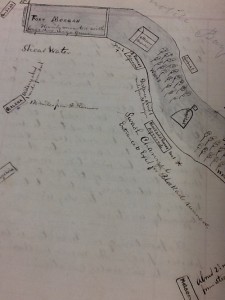By: Kevin Ray, Archival Technician
This week, in honor of the 150th anniversary of the Battle of Mobile Bay, Kevin Ray wrote a three-part account of the battle drawn from a combination of secondary sources and the two Union diaries by Ellsworth Hults and Eston C. Lambert. These two diaries are held in the Division of Special Collections. If you need a refresher, Monday’s post contained Part I. Part III will be posted on Monday, August 11, so check back soon!
Farragut had a large advantage in numbers. His fleet totaled eighteen ships. Of these, fourteen were wooden ships and four were iron-clad monitors. His battle plan was to steam past Fort Morgan’s guns and into the relatively deep water at the south end of Mobile Bay. To protect his smaller gunboats, Farragut ordered that each of them be lashed to the port side of one of the larger ships, away from direct fire from Fort Morgan. Thus tied together, the ships would steam into the bay in a line, two by two, following the iron-clad monitors.
Buchanan’s ships lined up just north of Mobile Point. Their battle plan was simple: attack any Union ships making it past the torpedoes and Fort Morgan’s guns. As the ships moved in, the Confederate artillery at Fort Morgan began firing. It was around seven in the morning.
Almost as soon the fighting started, the Union fleet found itself in a near calamity. The faster wooden ships were catching up to the slower iron-clad monitors in front. The lead monitor, USS Tecumseh, moved too far to the western end of the channel and into the torpedoes. As the Union line of battle slowed and began to pile up, Tecumseh hit a torpedo and sank within minutes, with the captain and most of the crew aboard. In the chaos, Admiral Farragut made a crucial, but risky decision. He gave orders to steer his flagship USS Hartford, and the gunboat USS Metacomet which was lashed to it, around the stalled ships in front of him. The new course went into the torpedoes. The ships behind followed the admiral. All risked destruction, but all made it through safely. Farragut’s command is usually rendered as “Damn the torpedoes! Full speed ahead!” Those may not have been his exact words, but the quote does express the sentiment of the moment. Farragut already had received intelligence reports that the torpedoes in the bay were largely defective, probably due to wet powder. It was still a risk to cross through them, but at that moment the only other options were to retreat or to stop in range of Fort Morgan’s guns. Farragut needed to keep moving.
Having made it past the torpedoes and Fort Morgan, the Union fleet entered a small area in the lower bay where the water was deep enough to accommodate the larger ships. Upon entering the bay they were met by Buchanan and his four ships. The three smaller Confederate gunboats were soon attacked by Union gunboats and taken out of action. CSS Gaines was damaged and began to take on water. She tried to make it to Fort Morgan, but was grounded and eventually sank. CSS Selma was pursued by Metacomet, overtaken, and finally surrendered. CSS Morgan eluded destruction and surrender, and made a daring run that night from the lower bay to Mobile and safety.


